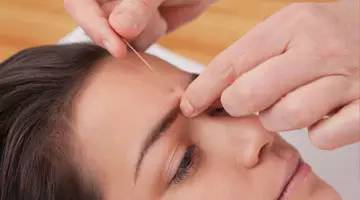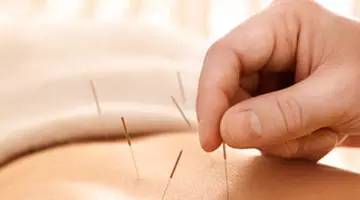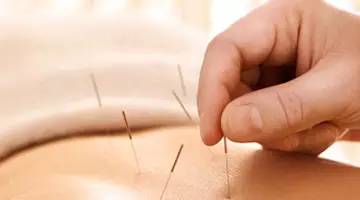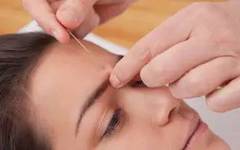1. Shu Point Needling
This acupuncture technique is used for treating diseases of the five organs. The term “shu” refers to the four limbs’ ying points and the five zang shu points located on the back, namely xin shu (Heart Shu), fei shu (Lung Shu), gan shu (Liver Shu), pi shu (Spleen Shu), and shen shu (Kidney Shu), which are used to treat diseases of the five organs. Since this technique targets specific shu points, it is called “shu point needling.” In clinical practice, Li’s method for treating pain from cholecystitis involves needling the dan shu (Gallbladder Shu) point, which can directly alleviate pain, as stated in the “Ling Shu: Chapter on Official Needling”: “Shu point needling refers to needling the ying and zang points of the meridians.”
2. Distant Needling
The lower he points can treat diseases of the six fu organs, and this technique is called distant needling. The lower he points refer to the six shu points where the qi of the six fu organs converges in the yang meridians of the lower limbs, primarily located near the knee joint. The “Ling Shu: Chapter on Evil Qi and Organ Disease” states: “To treat the internal organs… the stomach is connected to san li, the large intestine to ju xu (Upper Ju Xu), the small intestine to xia ju xu (Lower Ju Xu), the san jiao to wei yang (the outer edge of the biceps tendon), the bladder to wei zhong (the center of the transverse line), and the gallbladder to yang ling quan“; the “Ling Shu: Chapter on Official Needling” mentions: “Distant needling refers to treating a disease located above by needling below, targeting the fu points.”
For example, a patient named Zhang, a 51-year-old male driver, visited on January 31, 1990, after experiencing severe abdominal distension and discomfort following a large meal. Upon examination, the patient’s abdomen was distended and tender to touch. Acupuncture was performed on the san li points of both feet to promote qi flow and relieve stagnation, leaving the needles in for 15 minutes. The patient reported relief after passing gas. The next morning, he reported feeling normal with no other discomfort. This case illustrates that the patient’s abdominal distension was due to qi stagnation in the intestines after overeating, hence the treatment focused on the lower he points of san li to restore qi flow and achieve recovery.
3. Meridian Needling
This technique is used when there are accumulations along the meridians, such as stasis of blood, hard nodules, or tenderness. It is called “meridian needling” because it directly needles the major meridians. Li’s method for treating ganglion cysts primarily employs this technique, as do methods that involve palpation of the meridians and needling at points where positive responses are detected. The “Ling Shu: Chapter on Official Needling” states: “Meridian needling refers to needling the knots and connections of the major meridians.”
4. Luo Needling
This technique involves needling small luo vessels on the skin to induce bleeding and expel pathogenic factors. The “Su Wen: Treatise on Regulating the Menstrual Cycle” states: “When the disease is in the blood, regulate the luo.” The goal is to expel the pathogenic heat that stagnates between the luo vessels. The “Ling Shu: Chapter on the Origin of Diseases” states: “When the yang luo is injured, blood spills outside; when the yin luo is injured, blood spills inside.” Pathogenic heat causing blood overflow must be treated by regulating the luo vessels. Since this technique targets the luo vessels, it is called “luo needling.” Various modern clinical techniques, such as the three-edged needle (historically known as the sharp needle) or small needle knife bloodletting methods, fall under this category. The “luo needling (bloodletting) and cupping method” combines this technique with cupping therapy.

5. Fen Needling
This method involves needling directly into deep muscles to treat conditions such as stasis in the flesh and valley pain. The ancients referred to the deep muscles near the bones as “fen rou,” hence the term “fen needling.” This technique is used to needle points like huan tiao and zhi bian to treat conditions like piriformis syndrome. The “Su Wen: Treatise on Regulating the Menstrual Cycle” states: “When the disease is in the flesh, regulate the fen rou“; the “Ling Shu: Chapter on Official Needling” states: “Fen needling refers to needling between the fen rou.”
6. Da Xie Needling
This technique involves using a beryllium needle to incise and drain pus and blood, hence it is called “da xie needling” and is primarily classified under surgical methods. The “Ling Shu: Chapter on Official Needling” states: “Da xie needling refers to needling large pus with a beryllium needle.”
7. Mao Needling
This is a superficial needling technique used to treat skin surface conditions. Various specialized skin needles, such as the plum blossom needle, have been developed based on this technique. For instance, conditions like “skin neuritis” causing localized numbness can be effectively treated with this method. A patient from the Guiyang Key Highway Command, a 51-year-old male, visited on November 11, 1991, with a 30 cm x 15 cm area of numbness on the outer side of his right thigh. Diagnosed with “skin neuritis” and having sought various treatments without success, he came for this method and achieved significant improvement after a month of treatment, with no complaints during follow-up. As stated in the “Ling Shu: Chapter on Official Needling”: “Mao needling refers to needling superficial skin conditions.”
8. Ju Needling
This technique involves needling points on the opposite side of the body from where the disease is located, effectively treating conditions by needling healthy side points. Due to the interwoven nature of the meridians in the body, many points on the left and right intersect, such as the du mai at the da zhui point where the yang meridians of the hands and feet converge, or the ren mai at the zhong ji and guan yuan points where the yin meridians intersect. This allows the qi of the meridians to flow and transmit across sides. In clinical practice, for conditions like stroke-related hemiplegia, it is common to needle the opposite side, exemplifying the application of the “ju needling” technique. This method is frequently used in clinical settings. As stated in the “Ling Shu: Chapter on Official Needling”: “Ju needling refers to needling the left side for right conditions and vice versa.”
Similar to ju needling is the “miao needling,” which also involves needling the opposite side but differs in indications and methods. Needling the meridians is termed “ju needling,” while needling the luo vessels is termed “miao needling.”
Regarding the method of miao needling, the “Su Wen: Treatise on Miao Needling” states: “When the evil resides between the five organs, the disease causes pain that comes and goes. Depending on the condition, miao needling is performed on the hands and feet, observing the pulse and drawing blood… For pain without disease in the meridians, miao needling is applied, focusing on the blood vessels of the skin.” This indicates that miao needling targets the jing points of each meridian and the corresponding blood vessels of the skin.

9. Cui Needling
The “Ling Shu: Chapter on Official Needling” states: “Cui needling refers to needling with a heated needle to treat stasis.” The heated needle is inserted quickly into the skin after being heated red, similar to dipping a hand into hot soup. This method is used to treat cold stasis and is not suitable for treating localized heat or muscle relaxation conditions. The “Ling Shu: Chapter on Meridians and Tendons” states: “Heated needle needling is done with knowledge of the number of insertions and pain as the guide”; “Cui needling refers to urgent cold conditions; heat causes the tendons to relax and is ineffective for heated conditions.”
10. Ou Needling
This technique involves pressing on the chest and back to locate tender points directly corresponding to the area of pain, then needling one point in the front and one in the back to treat heart-related conditions while avoiding internal organ damage. Since this technique involves needling front and back, it is called “ou needling,” also known as “yin-yang needling.” In clinical practice, the “front-back matching point method” or the “yu-mu matching point method” used for treating organ diseases is a development of this technique.
11. Bao Needling
This technique is used to treat conditions with non-fixed pain. If the pain moves up and down, the needle is inserted directly, and during the retention of the needle, the left hand massages along the path of the pain, then the needle is withdrawn and reinserted. “Bao” implies “recovery”; hence, it is called “bao needling” because it involves re-insertion after withdrawal. This method is similar to the intermittent needling technique used in clinical practice, but bao needling involves re-insertion after withdrawal, while the latter involves repeated insertion during the needling process. As stated in the “Ling Shu: Chapter on Official Needling”: “Bao needling refers to needling in areas of variable pain, moving up and down, inserting directly without withdrawing the needle, while the left hand follows the pain to apply pressure, then withdrawing and re-inserting the needle.” This method is commonly used in conditions like sciatica, yielding satisfactory results.
12. Hui Needling
This technique involves needling from the side of the tendon, directly targeting the tendon with multiple transverse insertions to relieve tendon tightness, treating conditions like “tendon bi.” Due to the multiple insertions, this technique enhances the sensation of needling directly at the site of the condition, hence it is called “hui needling” (historically, “hui” was written as “da”). Although hui needling and the subsequent “guan needling” both target tendons, they each have distinct characteristics; the former involves lateral insertion with multiple transverse needling, while the latter involves direct insertion from the front. In clinical practice, both methods are often used in combination. The “Ling Shu: Chapter on Official Needling” states: “Hui needling refers to lateral insertion, with multiple transverse insertions to relieve tendon tightness, treating tendon bi.”
13. Qi Needling
This method involves needling one point directly in the center of the affected area and two additional points on either side, using all three needles simultaneously, hence the name “qi needling.” This method is also known as “three needling” and is used to treat conditions of cold bi that are deep but localized, such as low back pain and cervical spondylosis. The “Ling Shu: Chapter on Official Needling” states: “Qi needling refers to inserting one needle directly and two laterally to treat cold conditions that are slightly deep.”

14. Yang Needling
This method involves needling one point directly in the center and four additional points diagonally towards the center, used to treat conditions with a relatively shallow but larger area of bi. This technique is dispersed and superficial, embodying the meaning of “spreading,” hence it is called “yang needling.” The “Ling Shu: Chapter on Official Needling” states: “Yang needling refers to one direct insertion and four diagonal insertions to treat broad cold conditions.” In clinical practice, it is often used to treat subcutaneous nodules or ganglion cysts. Later practitioners believe that the skin needle known as the plum blossom needle is an evolution of the yang needling technique.
15. Zhi Needle Needling
This method involves a technique of needling along the skin surface, suitable for treating conditions with shallow cold that do not require deep needling. Since superficial needling can inadvertently draw the pathogenic factor deeper, this technique focuses on expelling superficial cold pathogens. Li’s method employs this technique for points like yang bai and di cang to treat conditions like facial pain. As stated in the “Ling Shu: Chapter on Official Needling”: “Zhi needle needling refers to needling along the skin to treat superficial cold conditions.”
16. Shu Needling
This technique involves inserting the needle directly in and out, with few rotations, deeply needling to the bone and retaining the needle for a long time. This method embodies the concept of drawing yin to support yang, used to treat conditions of excess heat. “Shu” implies “communication,” hence the name “shu needling,” and later practitioners’ “tian liang” technique and theory are derived from this. This is similar to commonly used strong and heavy stimulation techniques in clinical practice. The “Ling Shu: Chapter on Official Needling” states: “Shu needling refers to direct insertion and withdrawal, with few needles and deep insertion for conditions of excess heat.”
17. Duan Needling
The “Ling Shu: Chapter on Official Needling” states: “Duan needling refers to needling for bone bi, with slight shaking and deep insertion to reach the bone, moving up and down to rub the bone surface.” The term “duan” implies a slow insertion of the needle, requiring a gradual approach and movement of the needle to reach the bone, with quick upward movements and slow downward movements (quickly lifting the needle and slowly inserting it). This technique embodies the concept of drawing yang to support yin, treating conditions of cold that penetrate to the bone.

18. Fu Needling
The “Ling Shu: Chapter on Official Needling” states: “Fu needling refers to lateral insertion to treat muscle tightness and cold conditions.” This technique involves slanted shallow needling to treat muscle spasms of a cold nature. Fu needling, mao needling, and yang needling are all considered shallow needling techniques, but mao needling involves fewer needles, while yang needling involves multiple needles; fu needling is characterized by slanted insertion targeting the muscle layer. Modern applications of the intradermal needle technique are an evolution of fu needling. For instance, in clinical practice, it can be used to treat spasms of the tibialis anterior and fibularis longus muscles causing lower limb pain.
19. Yin Needling
The “Ling Shu: Chapter on Official Needling” states: “Yin needling refers to simultaneous needling on both sides to treat cold syndromes, particularly cold extremities and the posterior shaoyin of the ankles.” This method involves needling corresponding points on both sides (primarily referring to yin meridian points) simultaneously, such as needling the tai xi point behind the inner ankle to treat cold syndromes.
20. Bang Needling
This technique involves needling one point directly and then needling another point diagonally nearby. Another interpretation is that direct needling targets the meridian, while lateral needling targets the luo vessels. Since this technique combines direct and lateral needling, it is called “bang needling.” The “Ling Shu: Chapter on Official Needling” states: “Bang needling refers to one direct and one lateral insertion to treat lingering bi conditions.” This technique is similar to “qi needling,” both aiming to enhance local pain stimulation, differing only in the number of needles used. In clinical practice, both methods are often used in combination.
21. Zan Needling
The “Ling Shu: Chapter on Official Needling” states: “Zan needling refers to direct insertion and withdrawal, with multiple shallow insertions to induce bleeding, which is used to treat abscesses.” “Zan” implies supporting the dispersal of the condition, involving quick insertion and withdrawal to promote the rapid resolution of abscesses, hence the name “zan needling.”
22. Ban Ci
This method involves shallow needling on the skin, with rapid insertion that should not injure the muscles, akin to plucking a hair. This technique is associated with the lung, which governs the skin and hair. The “Ling Shu: Chapter on Official Needling” states: “Ban ci refers to shallow insertion and rapid insertion without injuring the flesh, akin to plucking hair, to expel superficial pathogenic factors, corresponding to the skin and lung.” Li often employs this method to treat conditions related to the lung, such as colds, fever, cough, and asthma, achieving good results with needling points like shao shang and yu ji.
23. Leopard Spot Needling
This method involves multiple insertions around the affected area, with the insertion points resembling the spots of a leopard, targeting the meridians. This technique is similar to the previous “zan needling” and “luo needling,” aiming to penetrate the blood vessels to induce bleeding. Since the heart governs the blood vessels, this technique corresponds to the heart. As stated in the “Ling Shu: Chapter on Official Needling”: “Leopard spot needling involves needling around the affected area, targeting the central meridian to draw blood from the meridians, corresponding to the heart.” This technique is clinically applicable for treating conditions like redness, swelling, and pain.
24. Guan Needling
This technique involves needling directly into the joints of the limbs, targeting the ends of the tendons, such as the du bi and qu chi points. This method can treat tendon bi, but care must be taken to avoid bleeding to prevent depleting the nutritive blood. Since the liver governs the tendons, this technique corresponds to the liver. The “Ling Shu: Chapter on Official Needling” states: “Guan needling refers to direct needling at the ends of the tendons to treat tendon bi, with caution to avoid bleeding, corresponding to the liver.” This method is also frequently used in clinical practice.
25. He Gu Needling
This acupuncture technique involves combining three or four needles to form a shape resembling a chicken’s foot. The term “he gu” here does not refer to the he gu point but rather to needling in fleshy areas, such as needling the feng shi point to treat lateral skin neuritis or the yao yang guan point to treat low back pain. Since the spleen governs the muscles, this technique corresponds to the spleen. The “Ling Shu: Chapter on Official Needling” states: “He gu needling refers to needling in the fleshy areas to treat muscle bi, corresponding to the spleen.”
26. Shu Needling
This technique involves direct insertion and withdrawal without excessive rotation, deeply needling to the bone to treat bone bi. The “Ling Shu: Chapter on Official Needling” states: “Shu needling refers to direct insertion and withdrawal, deeply penetrating to the bone to treat bone bi, corresponding to the kidney.” This technique is similar to the previously mentioned “shu needling” and can be used interchangeably in clinical practice.

